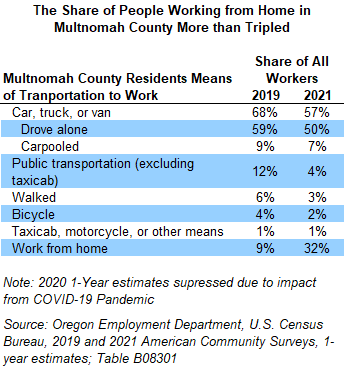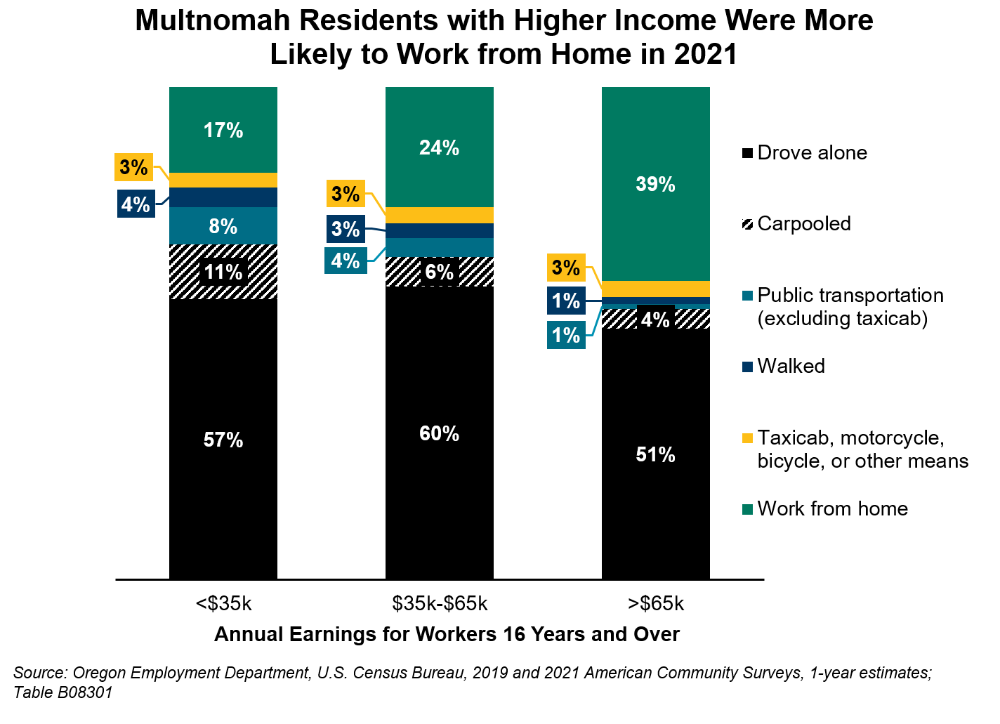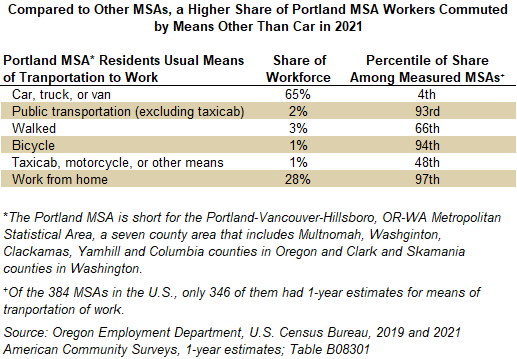Work from Home Rate Tripled in 2021 in Multnomah, Though Most Still Drive to Work
July 20, 2023The COVID-19 pandemic fundamentally shifted the way people work. Workers whose positions made it possible started working from home and thus shifted away from other means of transportation. The share of workers living in Multnomah County who worked from home more than tripled from 2019 to 2021. Every other means of commuting saw a significant decline. While the changes in commuting occurred across all income levels, the shift was especially pronounced in workers with higher incomes.

In 2021, an estimated 32% of workers living in Multnomah County worked from home most of the time, an increase of 23 percentage points from 2019. Multnomah had the highest share of residents working from home among Oregon counties with a population of at least 65,000.
Despite the large increase in work from home, most Multnomah residents still drove to work. Fifty-seven percent of workers drove to work in 2021, with 50% driving alone and 7% carpooling, declining 11 percentage points from 2019. Though high, this is considerably less than the rest of Oregon and the U.S. where 70% and 76% of workers drive to work, respectively.
In addition to driving, most other means of commuting dropped precipitously. The share of workers taking public transportation declined by two-thirds to 4%. We can see this in TriMet ridership data. In spring of 2019, there were 2.9 million boardings and alightings of buses and light rail in Multnomah. This dropped 60% to 1.2 million in spring 2021.
The shares of Multnomah residents who walked and biked to work each dropped by half to 3% and 2%, respectively. Though declining, Multnomah still has the highest share of residents biking to work among Oregon counties with at least 65,000 residents, tied with Benton and Polk counties at 2%. Those who took taxicabs, motorcycles, or other means remained at 1%.
Workers with Higher Incomes More Likely to Work from Home
In 2019 and earlier, means of transportation was similar across all income levels. For instance, between 69% and 76% of residents across all earnings levels drove to work, 10-14% took public transportation and 5-9% worked from home.
In 2021, stark differences emerged. The pandemic disproportionately affected commuting patterns across income ranges. Residents with annual earnings greater than $65,000 were much more likely to work from home (39%) than residents with annual earnings between $35,000 and $65,000 (24%) or less than $35,000 (17%). Residents with higher incomes were also less likely to take public transportation, drive alone or carpool, or walk. Rates of taking taxicabs, motorcycles, bicycles, or other means were similar across earnings levels.

The large differences in means of transportation are likely due to higher wage occupations (like legal occupations) having more remote work opportunities compared with low wage occupations (like sales and related occupations). You can read more about occupations that allow for work from home on QualityInfo.
Fewer People Drive to Work in Portland Metro Compared with Other Metro Areas
Looking at the Portland-Vancouver-Hillsboro Metropolitan Statistical Area (Portland MSA), an estimated 28% of residents worked from home in the seven county area. That was the 12th-highest estimated share amongst all MSAs in the U.S., behind the high of 36% for residents of the Boulder, Colo. MSA.

The Portland MSA has the 12th smallest share of drivers to work among MSAs in the U.S., at 65%. The New York, N.Y. MSA has the smallest share with 50% of workers driving for their commute.
Despite significant declines in the share of workers taking public transit and biking to work, Portland MSA residents still use those means of transportation at a very high rate compared with other MSAs. The Portland MSA is 23rd highest amongst MSAs with 2% of the workforce using public transit to commute, behind a high of 19% in the New York MSA. The Portland MSA was 21st highest for bike commuters with 1% of the workforce commuting that way behind a high of 4% in the Missoula, Montana MSA.
The Portland MSA was roughly average for the share of those commuting by walking and by taxicab, motorcycle, or other means.